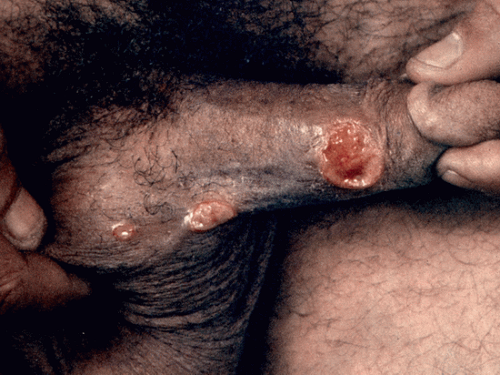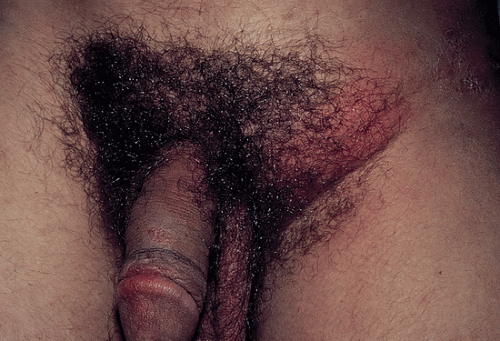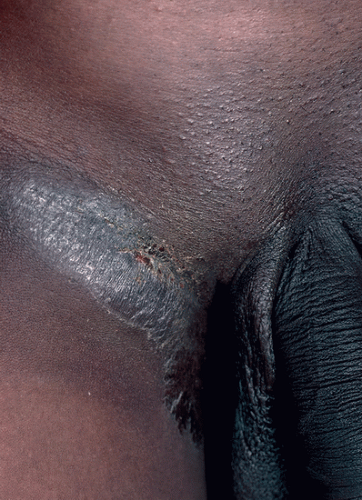Buboes
Chancroid
Genital ulcers
Granuloma inguinale
Lymphogranuloma venereum
Molluscum
Pubic lice
Scabies
strictures and chronic pain.6,7 These lesions can become superinfected with other STIs or pathogens.
| ||||||||||||||||||||||||
Primary stage: The initial lesion begins as a small, painless papule or pustule at the site of inoculation that can erode into an asymptomatic herpetiform ulcer that often heals without scarring within a week. Lesions are typically found on the penis, urethral glans, and scrotum in men and on the vulva, vaginal wall, fourchette, and cervix in women. Rectal lesions occur in both sexes from receptive anal intercourse and can be associated with diarrhea, rectal discharge, and tenesmus. Mucopurulent cervicitis and urethritis may also occur. Women usually have primary involvement of the rectum, vagina, and cervix.
Secondary or inguinal stage: This stage typically occurs 2 to 6 weeks after the appearance of the primary lesion and involves painful inflammation of the inguinal and femoral lymph nodes. Inguinal adenopathy is unilateral in 70% of cases and is more common in males (Fig. 62.2). The “groove” sign is the result of enlarged inguinal nodes above Poupart’s ligament and the femoral nodes below it and is considered “pathognomonic” for LGV (Fig. 62.3). Nodes can become matted and fluctuant and produce the characteristic bubo.7 Buboes may rupture in one-third of patients or develop into hard, nonsuppurative masses. Most buboes eventually heal, but some will form sinus tracts. Bubonic relapse occurs in 20% of untreated cases. Constitutional symptoms may occur with the inguinal buboes and be associated with systemic spread of chlamydia, leading to arthritis, hepatitis, and pneumonitis.
CDC Recommended Treatments
Other Management Considerations
Follow-Up
Azithromycin 1 g orally in a single dose or
Ceftriaxone 250 mg IM in a single dose or
Ciprofloxacin 500 mg orally twice daily × 3 d or
Erythromycin base 500 mg orally 3 times daily × 7 d
HIV-positive patients: May require longer or repeated treatment due to treatment failures and slow healing. Use single-dose therapies only when close follow-up assured.
Pregnancy/lactation: Ciprofloxacin contraindicated
Uncircumcised males: Higher treatment failure rates and slower healing especially if ulcers under foreskin
Sex partners: Examine and treat sex partners who had sexual contact with patient in the 10 days preceding the patient’s onset of symptoms
Within 3-7 d of start of therapy
Weekly follow-up until resolution of lesions and symptoms
Test for HIV at time of diagnosis and 3 mo later along with syphilis if initial test negative
Buboes (fluctuant adenopathy): Treat by aspiration for symptomatic relief and to prevent rupture or by incision and drainage with wound packing (more definitive). Clinical resolution of fluctuant lymphadenopathy is slower than that of ulcers.
Tertiary or genito-anorectal syndrome (uncommon): This stage occurs more often in women who were asymptomatic during previous stages and in men who have receptive anal intercourse.9 Patients initially develop symptoms of procto-colitis (anal pruritus, rectal discharge, rectal pain, tenesmus, and fever). Subsequent manifestations include perirectal ab-scesses, rectovaginal and anorectal fistulas, rectal strictures, and rectal stenosis. Chronic untreated LGV can lead to repetitive scarring and fistulous tract formation in the genital region.
| ||||||||||||||||
Stay updated, free articles. Join our Telegram channel

Full access? Get Clinical Tree






